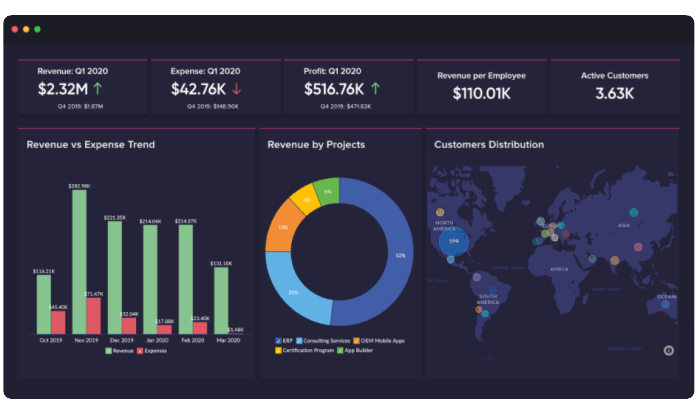Best data analytics software is the key to unlocking valuable insights from your data, empowering businesses to make informed decisions, improve efficiency, and gain a competitive edge. The data analytics software landscape is constantly evolving, with new trends and technologies emerging all the time. From data visualization and business intelligence to predictive analytics and data mining, there are a wide range of software options available to meet the needs of businesses of all sizes.
This comprehensive guide will delve into the key features of best data analytics software, explore various use cases and applications, and provide insights into choosing the right software for your specific business requirements. We will also discuss emerging trends in the data analytics software market and their potential impact on the future of data-driven decision making.
The Data Analytics Software Landscape: A Shifting Paradigm
The data analytics software landscape is a dynamic and ever-evolving ecosystem. Fueled by the relentless growth of data generation and the increasing demand for data-driven insights, the market is teeming with innovative solutions and burgeoning trends. Navigating this complex landscape requires a discerning eye, a keen understanding of the key players, and a comprehensive grasp of the diverse software categories available. This article will delve into the intricacies of the data analytics software landscape, providing insights into the current trends, key players, and the various software categories that shape this crucial field.
Current Trends in the Data Analytics Software Market
The data analytics software market is witnessing a confluence of trends that are reshaping its contours and influencing its future trajectory.
- The emergence of cloud-based analytics platforms is disrupting traditional on-premise solutions. Cloud-based platforms offer scalability, affordability, and accessibility, making data analytics accessible to a wider range of businesses and organizations.
- The rise of artificial intelligence (AI) and machine learning (ML) is injecting intelligence into data analytics software, enabling automated insights, predictive modeling, and real-time decision-making.
- The growing adoption of open-source tools and frameworks is fostering innovation and empowering developers to customize data analytics solutions to meet specific needs.
- The increasing focus on data privacy and security is driving the development of robust security features and compliance standards within data analytics software.
Key Players and Market Share
The data analytics software market is dominated by a handful of key players who compete fiercely for market share. These companies invest heavily in research and development, product innovation, and strategic acquisitions to maintain their dominance.
- Tableau is a leading provider of data visualization and business intelligence software, known for its user-friendly interface and powerful data exploration capabilities.
- Power BI from Microsoft is another prominent player, offering a comprehensive suite of data analytics tools integrated with the Microsoft ecosystem.
- Qlik is renowned for its associative data analysis capabilities, enabling users to explore data relationships and uncover hidden insights.
- SAS is a long-standing leader in statistical analysis and data mining, providing advanced analytics solutions for various industries.
- Alteryx is a popular platform for data preparation, blending, and analysis, offering a user-friendly drag-and-drop interface.
Software Categories: A Comparative Overview
Data analytics software encompasses a range of categories, each catering to specific data analysis needs. Understanding the nuances of these categories is crucial for selecting the right software for a particular business or organization.
- Data Visualization: This category focuses on presenting data in visually appealing and informative ways. Tools like Tableau, Power BI, and Qlik enable users to create interactive dashboards, charts, and graphs to communicate data insights effectively.
- Business Intelligence (BI): BI software goes beyond data visualization, providing tools for data exploration, analysis, and reporting. BI platforms like Tableau, Power BI, and Qlik offer features for data aggregation, trend analysis, and performance monitoring.
- Predictive Analytics: This category focuses on using historical data to predict future trends and outcomes. Predictive analytics software leverages statistical modeling, machine learning algorithms, and data mining techniques to identify patterns and make informed predictions.
- Data Mining: Data mining tools are designed to extract valuable insights from large datasets. These tools employ advanced algorithms to discover patterns, anomalies, and relationships within data, enabling businesses to uncover hidden trends and make data-driven decisions.
Key Features of Effective Data Analytics Software
Data analytics software is not a one-size-fits-all solution. Selecting the right software requires careful consideration of its key features and how they align with specific business needs. Here are some essential features that make data analytics software effective.
Data Integration Capabilities
Data integration is a critical aspect of data analytics, as it involves combining data from various sources into a unified view. Effective data analytics software should provide robust data integration capabilities, allowing users to connect to different data sources, including databases, spreadsheets, cloud services, and APIs.
Data Cleaning and Transformation
Data quality is paramount for accurate and reliable insights. Data analytics software should offer powerful data cleaning and transformation features, enabling users to handle missing values, inconsistencies, and errors within data.
Data Visualization Tools
Data visualization plays a crucial role in communicating data insights effectively. Data analytics software should provide a comprehensive set of data visualization tools, allowing users to create interactive dashboards, charts, and graphs to convey complex information in a clear and concise manner.
Statistical Analysis Functions, Best data analytics software
 best data analytics software” title=”Predictiveanalyticstoday” />
best data analytics software” title=”Predictiveanalyticstoday” />
Statistical analysis is essential for deriving meaningful insights from data. Data analytics software should offer a wide range of statistical functions, including descriptive statistics, hypothesis testing, regression analysis, and time series analysis.
User-Friendliness, Scalability, and Security
In addition to core data analytics features, user-friendliness, scalability, and security are crucial considerations when selecting data analytics software. User-friendly interfaces enable users with varying technical skills to access and analyze data effectively. Scalability ensures that the software can handle growing data volumes and user demands. Robust security features protect sensitive data from unauthorized access and cyber threats.
Use Cases and Applications of Data Analytics Software
Data analytics software has a wide range of applications across various industries, empowering businesses to make informed decisions, improve efficiency, and gain a competitive advantage.
Industries and Applications
| Industry | Applications |
|---|---|
| Retail | Customer segmentation, personalized recommendations, inventory optimization, fraud detection |
| Finance | Risk assessment, fraud detection, customer churn prediction, investment analysis |
| Healthcare | Patient segmentation, disease prediction, treatment optimization, drug discovery |
| Manufacturing | Predictive maintenance, supply chain optimization, quality control, process improvement |
| Marketing | Customer segmentation, campaign optimization, lead scoring, market research |
Specific Use Cases
- Customer Segmentation: Data analytics software can be used to segment customers based on their demographics, purchase history, and behavior. This allows businesses to tailor marketing campaigns and product offerings to specific customer groups, enhancing customer satisfaction and loyalty.
- Fraud Detection: Data analytics software can identify suspicious patterns and anomalies in transaction data, helping financial institutions and other businesses detect and prevent fraudulent activities.
- Predictive Maintenance: By analyzing sensor data and historical maintenance records, data analytics software can predict equipment failures before they occur, enabling businesses to schedule preventive maintenance and minimize downtime.
- Marketing Optimization: Data analytics software can analyze campaign performance data to identify the most effective marketing channels and optimize marketing campaigns for maximum ROI.
Choosing the Right Data Analytics Software
Selecting the right data analytics software is crucial for realizing the full potential of data-driven insights. Here’s a checklist of factors to consider when making this decision.
Factors to Consider
- Features: Evaluate the software’s features and capabilities to ensure they align with your specific data analysis needs.
- Pricing: Consider the software’s pricing model, including licensing fees, subscription costs, and potential add-on charges.
- Ease of Use: Choose software that is user-friendly and intuitive, allowing users with varying technical skills to access and analyze data effectively.
- Compatibility: Ensure that the software is compatible with your existing systems and data sources.
- Support and Training: Assess the vendor’s support and training resources to ensure you have access to the necessary assistance to maximize your software investment.
Comparison and Evaluation
Once you’ve identified a few potential software options, compare and contrast them based on their features, pricing, ease of use, and compatibility with your existing systems. Evaluate each software based on your specific business needs and data analysis requirements.
Data Analytics Software Trends and Future Outlook: Best Data Analytics Software
The data analytics software landscape is constantly evolving, driven by emerging trends and technological advancements. Here are some key trends shaping the future of data analytics software.
Emerging Trends
- Artificial Intelligence (AI) and Machine Learning (ML): AI and ML are transforming data analytics software, enabling automated insights, Predictive Modeling, and real-time decision-making.
- Cloud-Based Analytics: Cloud-based analytics platforms are gaining popularity, offering scalability, affordability, and accessibility to a wider range of businesses and organizations.
- Edge Analytics: Edge analytics involves processing data at the source, closer to where it is generated, reducing latency and enabling real-time insights.
- Data Democratization: The democratization of data analytics aims to make data accessible to a wider audience, empowering non-technical users to leverage data insights.
Future Impact
These trends are shaping the future of data analytics software, empowering businesses to unlock the full potential of their data. AI and ML are enabling more intelligent and automated insights, while cloud-based analytics platforms are making data analytics more accessible and scalable. Edge analytics is enabling real-time decision-making, and data democratization is empowering non-technical users to leverage data insights.






